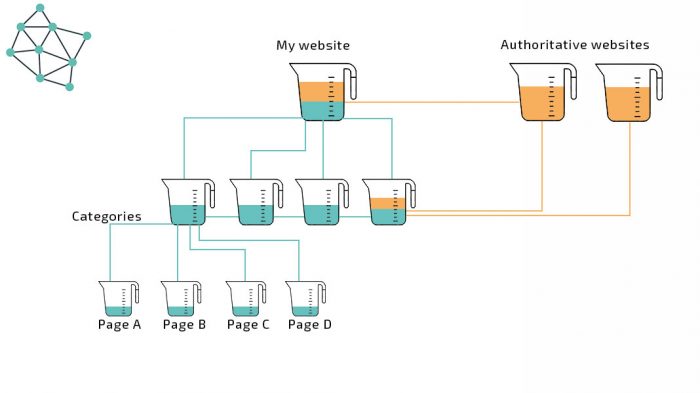Google is becoming more and more obsessed with the quality of content and links placed within pieces. As digital marketers, we must adjust and reverse-engineer our SEO approaches to adapt and conquer the SERPs.
Manual link building is a set of white-hat tactics that have a significant impact on SEO results. The kicker is that those strategies are not novel but reverse-engineered and adapted to the real world.
Keep reading and learn how to get more out of manual link building (and why avoid automated methods)!
What is Manual Link Building?
Manual link building is any link building technique that requires manual work and a lot of effort to earn links (such as outreach). The distinctive trait of manual link building is that link builders control the entire process, from choosing websites for placing links to creating content. Manual link builders use ethical approaches to acquire links.
What are the Benefits of Manual Link Building vs. Automated?
Manual link building is a mundane work that nowadays requires heaps of time and a pinch of creativity as every website out there hunts for links too. On average, it takes two to three months to start earning links when doing so manually for a newly created site (we know this from our 6-year experience building links for B2B and B2C customers). This forces link builders to consider using «automated» approaches to get links by hitting the button, which may be the worst decision ever for search engine rankings.
Let’s get into the details.
Benefit #1: Have control over the quality of your links
Google wants webmasters to build natural, quality and editorially given backlinks. Manual link building offers that all. Contrarily, automated methods hurt your brand and rankings as links are built to spammy and low-quality domains (e.g., link farms, PBNs, forums, spammy directories, blog comments, etc.).
Note: Editorial backlinks are natural links that point out to other websites (most times, to pieces of content, stats, or homepages) and are placed to give readers more information on the topic. You do not pay for these links.
Manual link building tactics are also white-hat, meaning the link builder will dodge any black-hat practices considered link schemes that lead sites to be penalized.
Benefit #2: Choose your link prospects
Get full control over link prospecting with the manual approach. Cherrypick sites for domain authority, topical relevance, monthly organic traffic, and content quality. This way, you’re going to build links only from relevant, high-authority domains. In turn, high-quality links give a greater ranking boost. Thus, manually acquired backlinks maximize SEO benefits.
Automated techniques don’t allow you to vet link prospects, so you play with fire and never know what links you’ll get.
Benefit #3: Future-proof your SEO
As Google updates come and go and the algorithms change all the time, it’s vital to acquire high-quality, relevant, and white-hat backlinks in order to avoid the risk of getting penalized. Manually built links from corporate blogs and other outlets are your bulletproof vest against Google updates. This works because corporate sites also invest in growing their web presence, increasing their DA. The higher a site’s DA, the more link equity it passes.
With that, let’s discuss the 5 tactics for acquiring links that work wonders.
5 Manual Link Building Strategies for Quality Backlinks
In this chapter, we’ve outlined the 5 most effective methods to earn links for any niche.
Strategy #1: Guest post outreach
Guest blogging outreach is one of the most common manual link building tactics that comes with its pros and cons. Guest posting is when you write articles for external blogs as a guest author.
Some pros include:
- Select websites you want to earn links from;
- Decide on anchor text;
- Link to any of your web pages;
- Get extra benefits from guest blogging, such as referral traffic and brand awareness.
The biggest downside of guest posting is the time and effort it takes, but it pays off in spades. Let’s quickly go through the outreach process.
1. Link prospecting (aka find websites for linking back to them).
At DigitalOlympus, we define traditional and smart link prospecting. Traditional methods include:
1. Scrapping the SERPs with paid and free tools like PitchBox, Scrape for SEO, and SEOquake Toolbar. You can also scrape the SERP manually, which will take much more time. In both options, the first step is to identify niche-related search operators to find guest blogging opportunities. For example:
-
- {keyword} «write for us» (e.g., board games «write for us»)
- {Keyword} «guest post»
- {Keyword} «guest article»
- {Keyword} «guest post opportunities»
- {Keyword} «submit blog post»
- {Keyword} «contribute to our site»
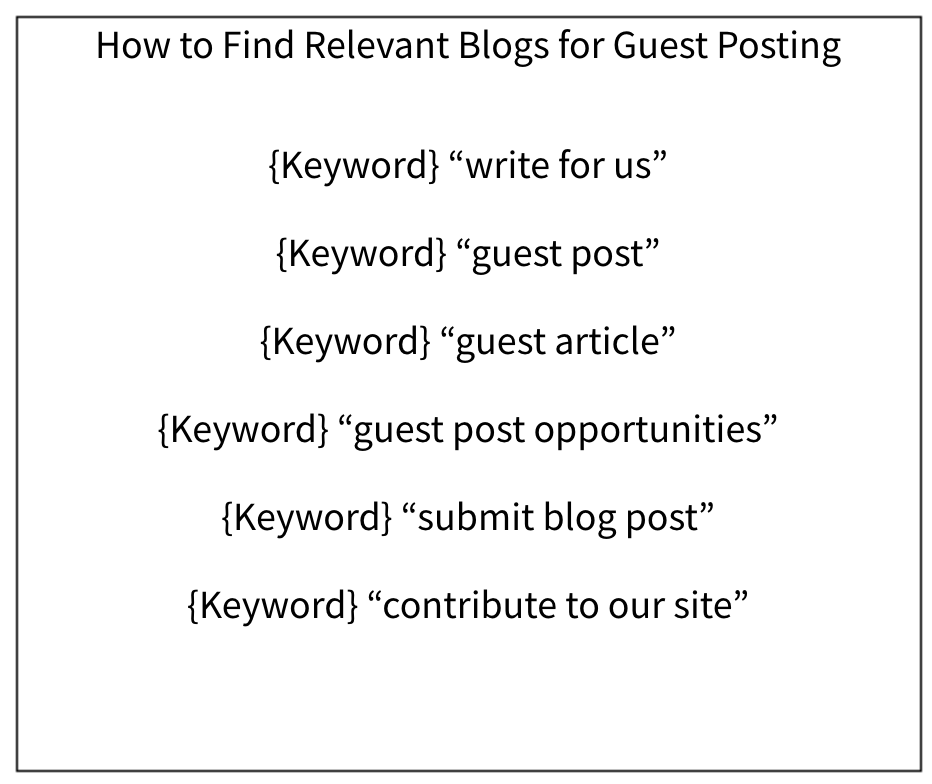
How to find guest blogging opportunities
2. Broken link building is another popular traditional method of link prospecting. Here you intend to find broken web pages with a decent number of inbound links. Then, analyze what sites link back to the broken page. Look back in history with the Wayback machine to see what content was featured. And lastly, write a better piece of content and reach out to webmasters, pointing out that they link to the broken page, but you have awesome content to fix this hiccup.
3. Chasing competitors' backlinks is also a common way to earn links. Monitor newly published URLs that link back to your rivals, and try to appear there, too. You can do so with Linkody. Another way is to use Ahrefs' «Backlinks» report to uncover relevant backlink opportunities.
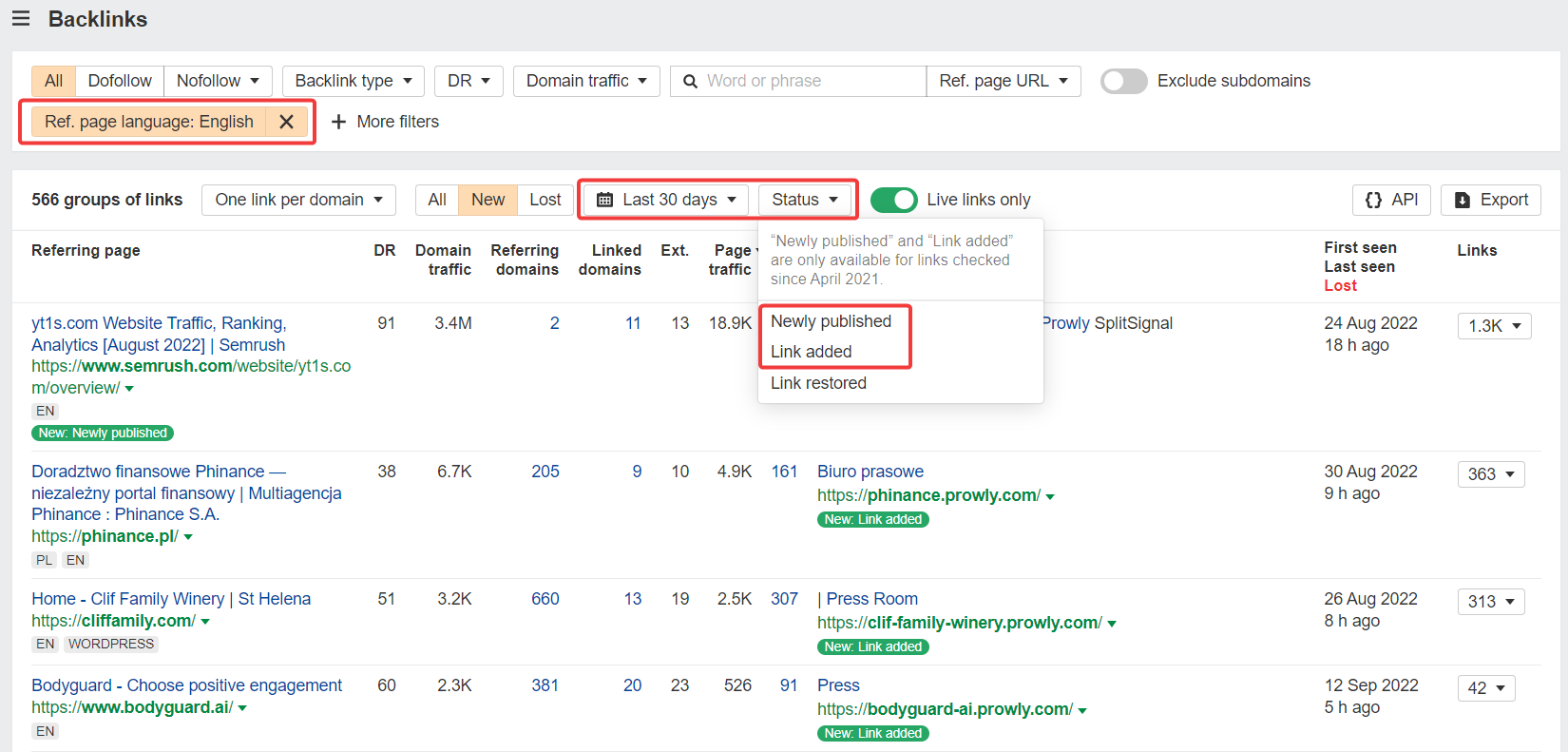
Set up filters to find recent links to your competitors with Ahrefs
Traditional link prospecting methods give you a big field of quality sites to work on. On the other hand, you’ll pitch to strangers most of the time, which lessens the number of backlinks. In turn, smart link prospecting helps you secure more high-quality links in less time.
Smart link prospecting is leveraging your circles. It’s all about partners, clients, social media followers, and professional communities. This is the most effective way to build links when starting out as you want to collaborate with people you know.
Plus, seek out your brand mentions on LinkedIn, Twitter (social media in general), and across the web. People partner up more willingly when they know about the brand. Search the web for brand mentions using BrandWatch, Brand24, or Mention.
But once again, let us reiterate the importance of focusing only on niche-relevant prospects.
"Avoid guest posting on websites that are not relevant to your niche. That will only hurt you. It sends search engines like Google a mixed signal about what your website is about. That will in turn hurt your chances of ranking for the keywords you actually want to rank for." — Joey Trend, Chief Executive Officer at HUM JAM.
Note: We wrote an extremely powerful guide on link prospecting that reveals all the tactics and tools we use. Check it out if you want to dig deeper and understand the entire process of outreach link building from the link building agency perspective.
2. Find prospects' contact information
Once you collect and vet domains for backlink collaborations via guest post outreach, the next step is to find the right contacts to send your pitch to. We usually contact editors and content marketers when outreaching corporate blogs. If we don’t hear back, we’ll contact their marketers or SEOs.
3. Launch outreach campaigns
The final step is to master personalization in your emails. You aim to create unique opening lines for every prospect on your list. Show them value and samples of content you produce, and be genuine.
Sometimes the best approach is to be fully transparent about your objectives and offer a hard-to-reject collaboration.
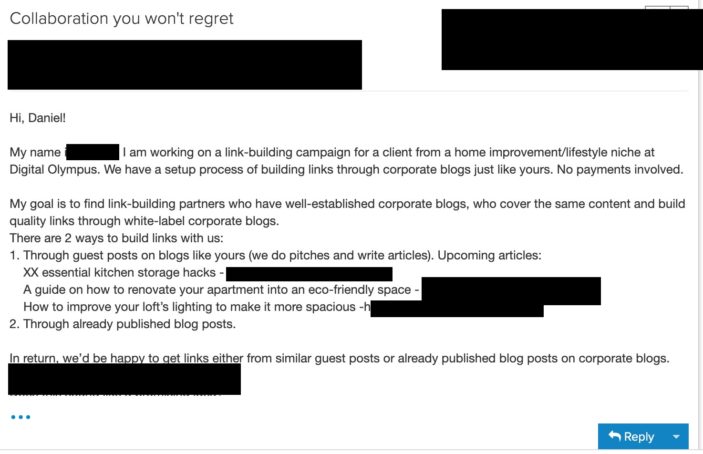
Also, you should be careful about the data you use to personalize your pitch, says Clarissa Filius:
«The most important thing is to avoid looking at the wrong data. There are many metrics to determine the authority of a domain, but you should never rely on just one number (eg. DA or DR). It is a common mistake to rely on tools, when you should also use common sense.
Another common mistake is using the same strategy for every market. Every client, market and country is different, so make sure you change your outreach approach based on this." — Clarissa Filius, Team Lead SEO at iO Digital.
Now let’s discuss other manual strategies to acquire dofollow links that will influence PageRank.
Strategy #2: Turn unlinked mentions into backlinks
Find unlinked brand mentions and decide which are worth linking to. Mentions from relevant and quality domains are what link builders want here. Here’s how to quickly find unlinked mentions.
- Find brand mentions manually with advanced search operators
Type the following string in the Google search bar and get a list of sites that mention your brand but don’t link back.
intext:{brand name} - {own domain name}.com -twitter.com -facebook.com -pinterest.com -youtube.com -linkedin.com
Example:
intext:Lemlist -lemlist.com -twitter.com -facebook.com -pinterest.com -youtube.com -linkedin.com
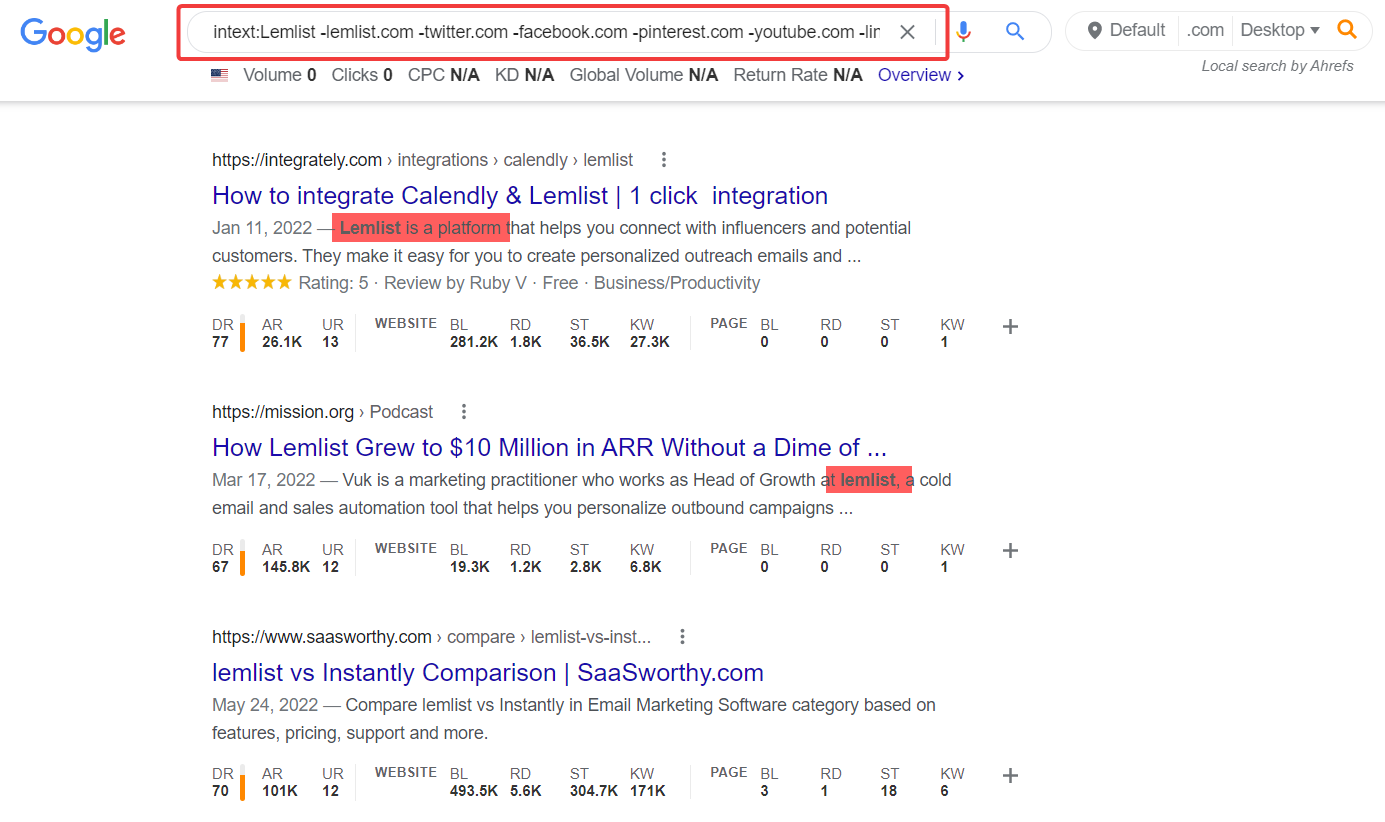
- Automate unlinked brand mentions search with Ahrefs
Using this approach, you’ll save dozens of hours and complete two tasks at once (finding and vetting domains in seconds).
- Go to Ahrefs Content Explorer and type your brand name.
- Create filters: Published (e.g., Last 30 days), Language, Only live.
- Click on «Highlight unlinked» and put your domain name.
Go through link prospects and select ones with high domain authority (DR) and topical relevance.
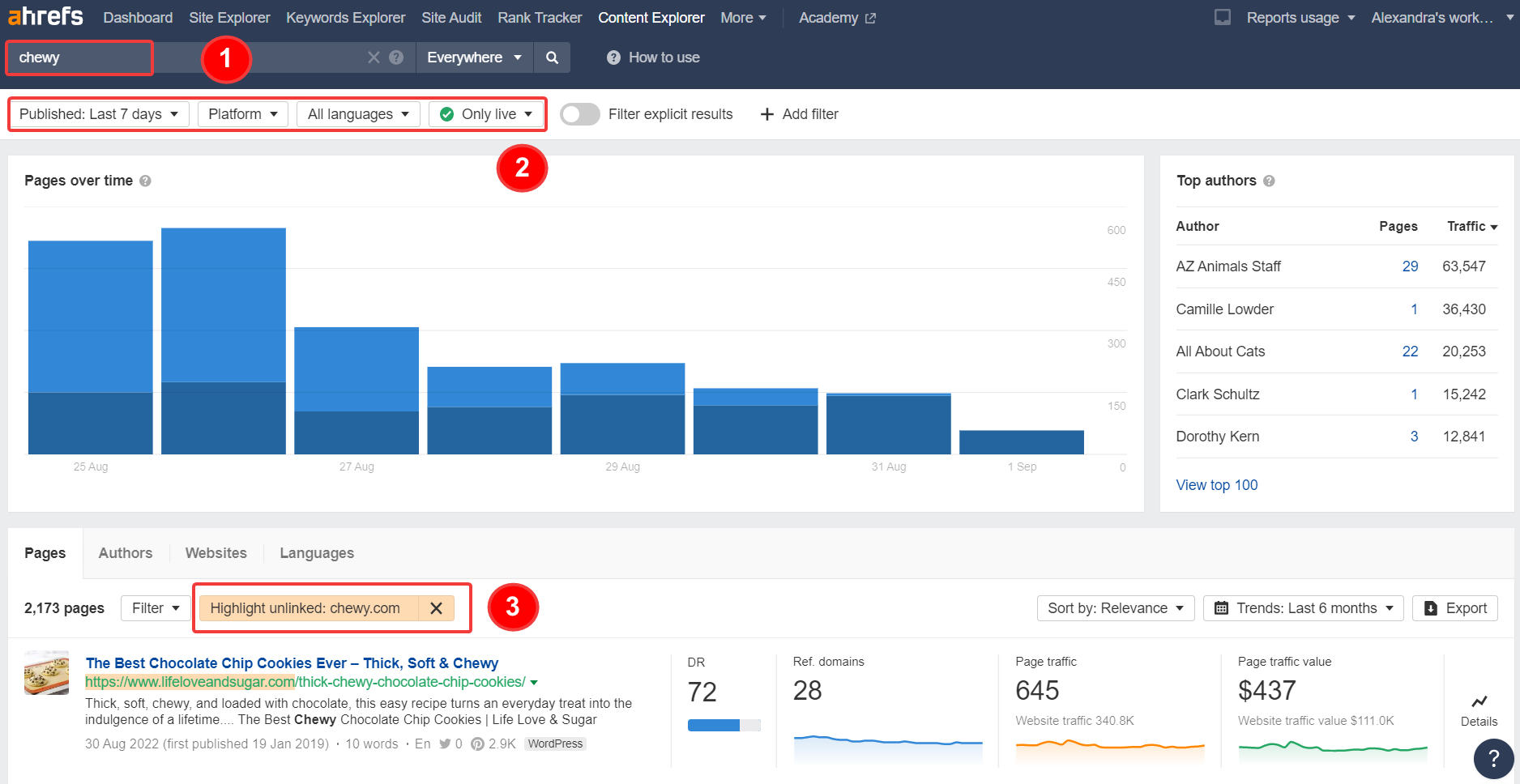
This tactic works well for big-name companies as they get mentioned every day. For small and mid-size companies, check brand mentions once per month.
Strategy #3: Pitch original research
Conducting original research and then pitching that research to journalists or industry-relevant websites is another great way to get backlinks.
Use product analytics, Google Analytics, and customer analytics to find eye-opening behavioral patterns and turn them into original content. For example, Ahrefs regularly digs into their data about sites' rankings, keywords, and backlinks to prove/disregard common beliefs about ranking factors and search engine optimization overall.
Likewise, CoSchedule suggests the best time to post on social media by analyzing trends in the engagement of the posts created with CoSchedule.
For non-product companies, the great way to collect unique data is to survey your industry, design infographics, or boast case studies. Here’s a great example of survey-based original research by Aira, a digital PR agency.

Once you have the data, format it into an enticing article and promote it through all the channels. Send it to journalists who cover that topic so they can occasionally refer to it. Pitch your learnings when answering journalists' requests on HARO. This will help you to stand out and increase the likelihood of securing a link from media outlets.
Original data-backed studies gather hundreds of links to your backlink profile if you put a great effort into content distribution.
Strategy #4: Use the Skyscraper Technique
This is a link building strategy where you find high-ranking content with tons of backlinks, spot its weak points and create a three times better piece of content. Then, you publish it on your blog and inform webmasters/editors about your new, top-notch content.
In your email, ask editors to read the piece and judge whether you’ve outperformed an existing copy in terms of quality and usefulness. Ask if they find your article worth linking back to. Pitch your blog post as an additional source. Don’t say, «the linked content is bad, and mine is cool.»
And most importantly, describe briefly why your content is great. Did you conduct new research? Surveyed 350 industry experts? Sparked up discussion about controversial POVs?
Here are some tips on how to create a better copy:
- Get in-depth — expand on tactics that were barely touched on;
- Back up content with unique data and SMEs'/influencers points of view — build more credibility around content by including different POVs and mentioning statistics;
- Create a better structure;
- Add extra items if the content type is a listicle;
- Mention your own experience or customer stories to make readers trust you;
- Add more graphics.
Your content must be a masterpiece and beat everyone in the industry.
Right now, you might be asking yourself — is the Skyscraper technique worth the effort?
Nikola Minkov from Serpact tested it with his team, and this strategy helped them outrank Amazon and Wikipedia for some queries. Here are some of his recommendations to make it work:
«Identify a hot and popular topic in some authoritative media and create much wider, more useful, and richer content than them. Use pictures, videos, infographics, and bullet points to outrank them.» — Nikola Minkov, CEO & Founder at Serpact.
Ultimately, he says, if Skyscraper Technique is performed properly, it can bring amazing results.
Strategy #5: Build links from quality resource pages
Getting listed on niche relevant and quality resource pages is another effective manual link building strategy.
Listicles are articles that include a lot of products, places, or other items. Examples include «35 best restaurants in Lisbon for vegetarians», «30 SEO plugins for competitor analysis», etc.
Every other blog creates such pieces related to its industry, so you can compile a list of such articles and ask editors to include your service.
This strategy brought Hunter. io, an email finder tool, 96 new links from 54 domains, and 33 new product listings in under 3 months. Worth mentioning that the team didn’t spend any time writing new pieces whatsoever. So building links from resource pages (aka listicles) is fast and cheap when done right.
Here’s a shortcut to using this tactic:
- Find niche-related resource pages using search strings like {keyword «best sites,» {keyword} «best blogs,» {keyword} «top places.» Example: fintech «best sites.» Click on each site in the SERP and copy-paste URLs to Google Sheets.
If you want to automate this process, use Ahrefs Keyword Explorer. Type the queries and export the results in CSV. - Analyze each site to see if your tool is mentioned and linked back. If not, contact webmasters and ask for either add the info about your service or claim the link.
This method also brings leads and a lot of referral traffic as these types of queries have commercial intent. Since you update listicles on the first two search engine results pages, your product is always in the spotlight.
These five tactics for manual link building secure good links for any industry. If you want to learn more, check out our recent piece with 25+ white-hat link building tactics.
How to Run a Manual Link Building Campaign in 4 Steps
No matter what strategy you choose, you should create a link building checklist to organize and streamline your efforts. Let’s go through the four most important steps.
Step #1: Choose your link building strategy (or strategies)
This step is about choosing which link building tactics you’re going to use. We don’t recommend sticking to one technique as the chances are you won’t get the expected results, especially at the beginning of your journey. On the other hand, don’t go wild trying to fit in 4−5 tactics all at once to avoid being overwhelmed.
So mix up two to three tactics and run several link building campaigns at the same time. First, you can opt for building links from resource pages, claiming unlinked brand mentions, and old-fashion guest posting.
If your content team has enough time, try to earn backlinks by using skyscraper content or conducting an original data study. Make sure to estimate your resources before undertaking a big project. You might need graphic designers and developers or data analysts to contrive and analyze the data.
Joseph S. Kahn also suggests his mix of link building strategies that worked for him and his team:
"I usually approach link building by focusing on quality over quantity. I employ a variety of strategies such as guest blogging, broken link building, and directory submission. I also use content-based strategies such as creating infographics, conducting interviews, and writing comprehensive blog posts. I also focus on outreach and relationship-building with other websites and influencers in the industry." — Joseph S. Kahn, President at Hum JAM.
According to Joseph, his team’s main goal is to make sure the topical relevance matches the domain.
Step #2: Create a list of link prospects
Once you decide on strategies, it’s time for link prospecting. This step is extremely important because not every link prospect is a good one. Some types of links might do more harm than good to your rankings.
Here are key factors for quality link prospects:
- Relevance. This is not a recommendation but a rule. The sites you build links from must be relevant to your niche. If lots of inbound links are irrelevant, it will lead to trouble, like losing rankings. Google’s Penguin algorithm watches for the quality of backlinks in terms of relevance and trustworthiness.
- Domain authority (aka trustworthiness or Ahrefs' domain rating). Choose websites with a DR of 30 and higher. Remember, the higher the DR, the more link equity your site will get.
- Beware of spammy sites. Link builders must evaluate link prospects for spammy signals to prevent building low-quality links and endangering sites from being penalized. Spammy signals include:
- Low organic traffic (like lower than 5K by SimilarWeb or 1−2K by Ahrefs);
- Suspicious sites that publish all-about content with awful design;
- Link farms, PBNs, fishy directories.
- Relevant traffic geography. Build links to the geography your business operates. If you target the USA market, make sure link prospects get the main traffic from the US, the UK, or CA. Avoid sites with traffic from India, Pakistan, Iran, etc.
Nikola Roza agrees with the above-mentioned factors:
"I look for relevant sites with real traffic. Domain level relevancy is a must for me because I think it’s extremely easy for Google to discount links that come from unrelated sites, while it’s unlikely they won’t honor a relevant link that seems logical and organically placed.
The other metric I pay attention to is the presence of real search engine traffic. Real in this case means they have to be ranking for keywords from their niche. This shows Google loves their site and that the link from them would likely help me.
Of course, if a site is relevant and gets traffic AND has some authority (from real links measured by Ahrefs and manually checked by me to see if there isn’t some kind of DR inflation trick going on) that’s just a cherry on the cake." — Nikola Roza, SEO and content marketing expert. (Website | LinkedIn)
Step #3: Organize your link prospects
Prepare a spreadsheet with prospects' contact information. Later, you’ll use it for setting up an email outreach campaign. You can also use the spreadsheet to track which prospects you have contacted and which have not. As an alternative, you can use PitchBox as a CRM to manage the link building process.

Use Google Sheets to organize link building campaigns
Step #4: Pitch your email
We’ve already mentioned that making emails as personalized as possible increases the chances of success. Now we want to outline some approaches to avoid when outreaching prospects:
1. Don’t use corny email templates you can find on Google. Editors and bloggers have seen such pitches a million times, so they irritate them rather than engage and foster connections.
2. Don’t butter up in opening lines with fluff words (e.g., I’ve been following you on LinkedIn, and you post great stuff!). This has nothing to do with personalization. Rather, it’s a banal and hackneyed approach that isn’t working. If you want to falter, be specific.
3. Don’t make a self-centered pitch. Check out the example below.

4. Use follow-ups. They increase the reply rate by 65.8%. From personal experience, a follow-up sequence of three to four emails can bring 200% more responses compared to sending just one email.
5. Don’t be boring in your pitches, and avoid long emails. Remember, you are building relationships with editors here.
Lastly, before hitting the button «Send,» ask yourself if you would answer the pitch. Do you really like it? If you feel that something is off, rewrite it.
Step #5: Create relevant content
Hyper-tailored pitches are great, but it’s not enough to capture editors' attention. What they care about is super high-quality content so their readers can derive value from it.
The following tricks will help you prove to editors that you will write outstanding pieces
1. Mention a toolkit you use to write guest posts. For example, mention a rising star SurferSEO for creating outlines and keyword optimization or its competitor Clearscope. This way, you ensure editors you’re likely to deliver great SEO-optimized content. In fact, this trick helped Hunter to reach a 34.5% reply rate, which is 500% higher than the benchmark of 7%.

2. Say that you will devote one headline to showcasing the prospect’s tool.
3. Bolster that you’ll interview SMEs for the piece, so prospects are likely to get higher engagement.
4. Include samples of your work published on popular blogs.
With these four easy steps, you can build a huge number of links like a pro!
Now Over to You
Manual link building requires patience and diligence as well as creativity and time. Link builders should know how to automate their process with SEO tools and sometimes a simple code. Be crazy good at time management to run campaigns smoothly and learn human psychology to craft enticing pitches.
If it sounds overwhelming, but you still want to streamline your link building efforts, consider outsourcing. We at Digital Olympus, a link building service provider, have been delivering links for B2B & B2C customers for over 6 years. We advocate a relationship-based approach and guarantee 100% white-hat links that help rank higher in organic search.
Want to see and learn more about us? Book a meeting with our team!


![Manual Link Building [Practical Guide with Strategies]](https://digitalolympus.net/files/Manual-Link-Building-Practical-Guide-with-Strategies-1.png)
